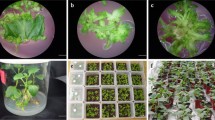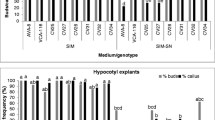Abstract
Both incubation temperature and photosynthetic radiation affected morphogenesis, callus culture and plantlet culture of sweet orange (Citrus sinensis) cultured in vitro. Bud culture from nodal stem segments, regeneration of shoots and buds from internode stem segments and induction of primary callus were near optimal at incubation temperatures between 21–30°C. The optimal temperature for root formation was 27°C with temperatures above and below being clearly deleterious. Incubation in the dark or under low photosynthetic photon flux density (PPFD) was beneficial for callus induction and growth and also favored the production of rooted plantlets from bud cultures. Incubation in the dark improved considerably the regeneration of shoots and buds from internode segments and the recovery of whole plants. No off-types, as determined by protein and isoenzyme analysis, were observed among plantlets recovered from bud cultures or from regeneration of shoots from internode stem segments.
Similar content being viewed by others
References
BarlassM & SkeneKGM (1982) In vitro plantlet formation from citrus species and hybrids. Scientia Hort. 17: 333–341
BeaazizM & SaadiM (1988) Preliminary identification of date palm cultivars by esterase isoenzymes and peroxidase activities. Can. J. Bot. 66: 89–93
BressanPH, KimYJ, HyndmanSE, HasegawaPM & BressanRA (1982) Factors affecting in vitro propagation of rose. J. Amer. Soc. Hort. Sci. 107: 979–990
ChaturvediHC & MitraG (1974) Clonal propagation of Citrus from somatic callus cultures. HortScience 9: 118–120
ConejeroV & SemancikJS (1977) Analysis of the proteins in crude extracts by polyacrylamide slab gel electrophoresis. Phytopathology 67: 1424–1426
DruartP, KeversC, BoxusP & GasparT (1982) In vitro promotion of root formation by apple shoots through darkness effect on endogenous phenols and peroxidases. Z. Pflanzenphysiol. 108: 429–436
Duran-VilaN, OrtegaV & NavarroL (1989) Morphogenesis and tissue cultures of three citrus species. Plant Cell Tiss. Org. Cult. 16: 123–133
EdrissMH & BurgerDW (1984) In vitro propagation of troyer citrange from epicotyl segments. Scientia Hort. 23: 159–162
GogorcenaY & OrtizJM (1988) Seed teguments as an aid to citrus taxonomy. J. Hort. Sci. 63: 687–694
GrinblatV (1972) Differentiation of citrus stem in vitro. J. Amer. Soc. Hort. Sci. 97: 599–603
HammerschlagFA (1978) Influence of light intensity and date of explantation on growth of geranium callus. HortScience 133: 153–154
HasegawaPM, MurashigeT & TakatoriFH (1973) Propagation of asparagus through shoot apex culture. II. Light and temperature requirements, transplantability of plants, and cyto-histological characteristics. J. Amer. Soc. Hort. Sci. 98: 143–148
IglesiasL, LimaH & SimónJP (1974) Isozyme identification of zygotic and nucellar seedlings in Citrus. J. Hered. 65: 81–84
Khosh-KhuiM & SinkKC (1982) Rooting-enhancement of Rosa hybrida for tissue culture propagation. Scientia Hort. 17: 371–376
KuhnsLJ & FretzTA (1978a) Distinguishing rose cultivars by polyacrylamide gel electrophoresis I. Extraction and storage of protein and active enzymes from rose leaves. J. Amer. Soc. Hort. Sci. 103: 503–508
KuhnsLJ & FretzTA (1978b) Distinguishing rose cultivars by polyaacrylamide gel electrophoresis II. Isoenzyme variation among cultivars. J. Amer. Soc. Hort. Sci. 103 509–516
LeshemB, Lilien-KipnisH & SteinitzB (1982) The effect of light and of explant orientation on the regeneration and subsequent growth of bulblets on Lilium longiflorum Thunb. bulb scale sections cultured in vitro. Scientia Hort. 17: 129–136
MurashigeT & SkoogF (1962) A revised medium for rapid growth and bioassays with tobacco tissue cultures. Physiol. Plant. 15: 473–497
StimartDP & AscherPD (1981) Foliar emergence from bulblets of Lilium longiflorum Thunb. as related to in vitro generation temperatures. J. Amer. Soc. Hort. Sci. 106: 446–450
ZimmermanRH (1984) Rooting apple cultivars in vitro: Interactions among light, temperature, phloroglucinol and auxin. Plant Cell Tiss. Org. Cult. 3: 301–311
Author information
Authors and Affiliations
Rights and permissions
About this article
Cite this article
Duran-Vila, N., Gogorcena, Y., Ortega, V. et al. Morphogenesis and tissue culture of sweet orange (Citrus sinensis (L.) Osb.): Effect of temperature and photosynthetic radiation. Plant Cell Tiss Organ Cult 29, 11–18 (1992). https://doi.org/10.1007/BF00036140
Received:
Accepted:
Issue Date:
DOI: https://doi.org/10.1007/BF00036140




